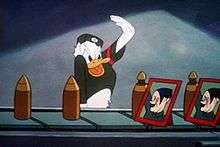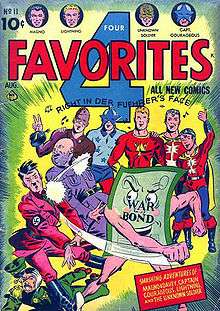Der Fuehrer's Face
Der Fuehrer's Face (originally titled Donald Duck in Nutzi Land[2]) is a 1943 American animated anti-Nazi propaganda short film produced by Walt Disney Productions, created in 1942 and released on January 1, 1943 by RKO Radio Pictures. The cartoon, which features Donald Duck in a nightmare setting working at a factory in Nazi Germany, was made in an effort to sell war bonds and is an example of American propaganda during World War II.[3] The film was directed by Jack Kinney and written by Joe Grant and Dick Huemer.[4] Spike Jones released a version of Oliver Wallace's theme for the short before the film was released.
| Der Fuehrer's Face | |
|---|---|
 Original theatrical film poster | |
| Directed by | Jack Kinney |
| Produced by | Walt Disney |
| Story by | Joe Grant Dick Huemer |
| Starring | Clarence Nash Billy Bletcher |
| Music by | Oliver Wallace |
| Animation by | Bob Carlson Les Clark Bill Justice Milt Neil Charles Nichols John Sibley |
| Layouts by | Don DaGradi Andy Engman[1] |
| Color process | Technicolor |
Production company | |
| Distributed by | RKO Radio Pictures |
Release date |
|
Running time | 8 minutes |
| Country | United States |
| Language | English |
Der Fuehrer's Face won the Oscar for Best Animated Short Film at the 15th Academy Awards. It was the only Donald Duck film to receive the honor, although eight other films were also nominated.[5] In 1994, it was voted Number 22 of "the 50 Greatest Cartoons" of all time by members of the animation field.[6]
However, because of the propagandistic nature of the short, and the depiction of Donald Duck as a Nazi (albeit a deeply reluctant one), Disney kept the film out of general circulation after its original release. Its first home video release came in 2004 with the release of the third wave of the Walt Disney Treasures DVD sets.
Plot
A German oom-pah band — composed of Axis powers leaders Joseph Goebbels on the trombone, Heinrich Himmler on the snare drum, Hideki Tojo on the sousaphone, Hermann Göring on the piccolo and Benito Mussolini on the bass drum — marches noisily at four o'clock in the morning through a small town where the trees, windmills, fence posts, and even the clouds are shaped like swastikas, singing the virtues of the Nazi doctrine. As they near Donald Duck's house, Donald heils to the song in his sleep. His alarm clock, with all the numbers replaced with swastikas, goes off and he smashes it. His cuckoo clock with a bird that is dressed up as Adolf Hitler heils as a clock chime, only for Donald to throw a shoe at it. Passing by Donald Duck's house (the features of which depict Hitler), the band members poke him out of bed with a bayonet to get him ready for work. Here Donald then faces and heils the portraits of Der Führer (Hitler), the Emperor of Japan (Hirohito) and Il Duce (Mussolini) respectively, then goes to make breakfast.
Because of wartime rationing, Donald's breakfast consists of bread that is so stale and hard it resembles wood (and must be sliced using a saw), coffee brewed from a single hoarded coffee bean, and a bacon and egg-flavored breath spray. The band shoves a copy of Mein Kampf in front of him for a moment of reading, then marches into his house and escorts him to a factory, with Donald now carrying the bass drum and Göring kicking him.

Upon arriving at the factory (at bayonet-point), Donald starts his comical 48-hour daily shift of screwing caps onto artillery shells coming at him in an assembly line. Mixed in with the shells are portraits of the Führer, so Donald must perform the Hitler salute every time a portrait appears, all the while screwing the caps onto shells, much to his disgust. Each new batch of shells is of a different size, ranging from individual bullets to massive shells as large as Donald (if not larger). The pace of the assembly line intensifies (as in the Charlie Chaplin comedy Modern Times), and Donald finds it increasingly hard to complete all the tasks. At the same time, he is bombarded with propaganda messages about the purported superiority of the Aryan race and the glory of working for the Führer.
After a "paid vacation" that consists of making swastika shapes with his body for a few seconds in front of a painted backdrop of the Alps as exercise, Donald is ordered to work overtime. He has a nervous breakdown with hallucinations of artillery shells everywhere, some of which are snakes and birds, some sing and are the same shape of the marching band from the start, music and all (some of the animation from this sequence is recycled from the "Pink Elephants on Parade" sequence from Dumbo).
When the hallucinations clear, Donald finds himself in his bed, and realizes that the whole experience was a nightmare; however, he sees the shadow of a figure holding its right hand up in the form of a Nazi salute. He begins to do so himself until he realizes that it is the shadow of a miniature Statue of Liberty, holding her torch high in her right hand. Remembering that he lives in the United States, Donald embraces the statue, saying, "Am I glad to be a citizen of the United States of America!"
The short ends with a caricature of Hitler's angry face, and a tomato is thrown at it, forming the words The End.
Song
| "Der Fuehrer's Face" | |
|---|---|
| Single by Spike Jones and His City Slickers | |
| Recorded | 1942 |
| Songwriter(s) | Oliver Wallace |
Before the film's release, the popular band Spike Jones and His City Slickers, noted for their parodies of popular songs of the time, released a version of Oliver Wallace's theme song, "Der Fuehrer's Face" (also known informally as "The Nazi Song") in September 1942 on RCA Victor Bluebird Records #11586.[7] The song parodied the Nazi anthem, the "Horst Wessel Song". Unlike the version in the cartoon, some Spike Jones versions contain the rude sound effect of an instrument he called the "birdaphone", a rubber razzer (also known as the Bronx Cheer)[8] with each "Heil!" to show contempt for Hitler[9] (Instead, the cartoon version features the sound of a tuba.) The so-called "Bronx Cheer" was a well-known expression of disgust in that time period and was not deemed obscene or offensive. The sheet music cover bears the image of Donald Duck throwing a tomato in Hitler's face. In the Jones version, the chorus line, "Ja, we is the Supermen—" is answered by a soloist's "Super-duper super men!" effeminately delivered[8] suggesting the prevalence of epicenes in the Party; in the Disney version, these lines are flatly delivered but with effeminate gestures by Hermann Göring. The recording was very popular, peaking at No. 3 on the U.S. chart.[9][10]
Other versions
- Johnny Bond recorded the song in July 1942 on the OKeh label.[11]
- Tommy Trinder recorded the song in the United Kingdom soon after the cartoon's release.
- Harry Turtledove adapted the song in one of his Colonization novels, in tune with the novels' theme of an alternate history alien invasion during World War II. See the page on the Race for the lyrics.

Political themes
Although the film portrays events in Nazi Germany, its release came while the United States also was on total war footing. Coffee, meat and food oils were rationed, civilians were heavily employed in military production, and propaganda in support of the war effort (such as the film itself) was pervasive. The film's criticism therefore emphasizes violence and terror under the Nazi government, as compared with the dull grind that all the warring nations faced.[12]
Censorship
In 2010, Der Fuehrer's Face was ruled by a local court in Kamchatka, Russia to be included in the national list of extremist materials, which was first created in 2002. This was due to a local who received a suspended sentence of six months for uploading it to the internet and "inciting hatred and enmity". On July 21, 2016, another Russian court reversed the ruling of the local court, removing the short film from the list. The court highlighted that the film's portrayal of Nazism through caricature form cannot be deemed "extremist" in nature.[13]
In other media
- In August 1943, the cover of Four Favorites comic (Number 11), displayed the four favorites — from left to right, The Unknown Soldier, Captain Courageous, Lightning, and Magno, the Magnetic Man (along with Davey, his boy partner) — all singing "Der Fuehrer's Face" in the background, whilst a strong and powerful "War Bond" simultaneously knocks out Emperor Hirohito, Adolf Hitler, and Benito Mussolini with one fierce blow in the foreground.
Releases
- 1943 – original theatrical run
- 2004 – Walt Disney Treasures: On the Front Lines (DVD)
- 2005 – Walt Disney Treasures: The Chronological Donald, Volume Two (DVD)[1]
Further reading
- Young, Jordan R. (2005). Spike Jones Off the Record: The Man Who Murdered Music (3rd edition) Albany: BearManor Media ISBN 1-59393-012-7.
References
- "Der Fuehrer's Face". Encyclopedia of Disney Animated Shorts. Archived from the original on June 10, 2016.
- "New U.S. War Songs". LIFE. 13 (18): 44. 2 November 1942. Retrieved 20 January 2012.
- Blitz, Marcia (1979). Donald Duck. New York: Harmony Books. p. 133. ISBN 0-517-52961-0.
- "Der Fuehrer's Face". BCDB. 2012-12-16.
- Biographies of 10 Classic Disney Characters from Walt Disney Archives at D23: The Official Disney Fan Club
- Beck, Jerry (1994). The 50 Greatest Cartoons: As Selected by 1,000 Animation Professionals. Turner Publishing. ISBN 978-1878685490.
- "The Week's Best Releases". Billboard. September 26, 1942. p. 66. Retrieved June 17, 2014.
- "Pop Chronicles 1940s Program #5". 1972.
- "SCORN AND DISDAIN SPIKE JONES GIFFS HITLER DER OLD BIRDAPHONE, 1942". April 8, 2009. Archived from the original on April 8, 2009.
- Whitburn, Joel (1986). Pop Memories 1890-1954. Menomonee Falls, Wisconsin: Record Research, Inc. p. 242. ISBN 0-89820-083-0.
- "Praguefrank's Country Music Discography: Johnny Bond". Retrieved 11 December 2015.
- Van Riper, A. Bowdoin (2011) Learning from Mickey, Donald and Walt: Essays on Disney's Edutainment Films
- Kozlov, Vladimir (21 July 2016). "Oscar-Winning Donald Duck Short About Nazi Germany Taken Off Russia's List of Extremist Material". The Hollywood Reporter. Retrieved 21 July 2016.
External links
| Wikiquote has quotations related to: Der Fuehrer's Face |